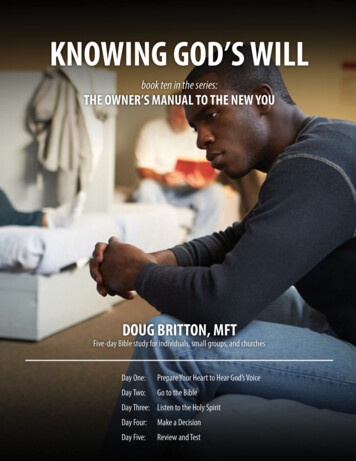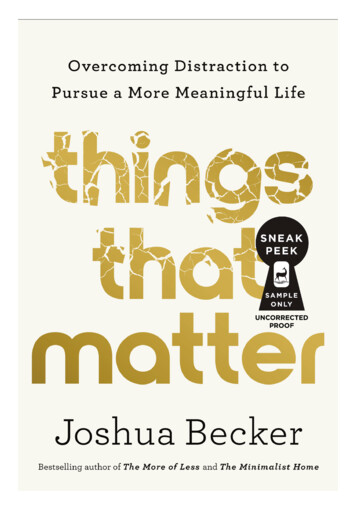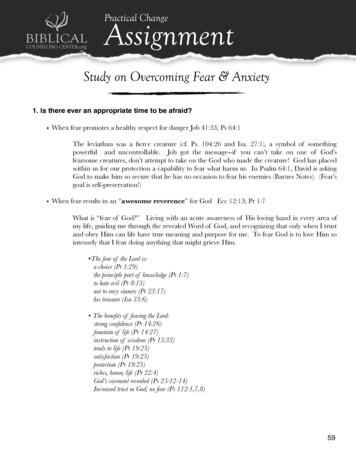
Transcription
OvercomingFear andDiscouragementKAY ARTHURDAVID LAWSONBOB VEREENHARVEST HOUSE PUBLISHERS
EUGENE, OREGON
Except where otherwise indicated, all Scripture quotations in thisbook are taken from the New American Standard Bible , 1960, 1962, 1963, 1968, 1971, 1972, 1973, 1975, 1977, 1995by T he Lockman Foundation. Used by permission.Verses marked NIV are taken from the Holy Bible: NewInternational Version . NIV . Copyright 1973, 1978, 1984 bythe International Bible Society. Used by permission of ZondervanPublishing House. T he “ NIV” and “ New International Version”trademarks are registered in the United States Patent andT rademark Office by International Bible Society.Except where otherwise indicated, all maps and charts in thisbook, as well as the “ How to Get Started” portion of theintroductory material, have been adapted and condensed from TheNew Inductive Study Bible, Copyright 2000 by PreceptMinistries International.Cover by Koechel Peterson & Associates, Minneapolis, MinnesotaThe Ne w Inductive Study Se rie sO VERCO MING FEAR AND DISCO URAGEMENTCopyright 1999 by Precept Ministries International
Published by Harvest House PublishersEugene, Oregon 97402Library of Congress Cataloging-in-Publication DataArthur, Kay, 1933–Overcoming fear and discouragement / Kay Arthur,David Lawson, and Bob Vereenp. cm. — (T he new inductive study series)ISBN 0-7369-0810-21. Bible. O.T. Ezra—Study and teaching 2. Bible. O.T.Nehemiah—Study and teaching. 3. Bible. O.T. Esther—Study and teaching. I. T itle. II. Series: Arthur, Kay, 1933–New inductive study series.BS1355.5.A78 1999222’.7’0071—dc2199-21976CIPAll rights re se rve d. No part of this publication may bereproduced, stored in a retrieval system, or transmitted in anyform or by any means—electronic, mechanical, digital,photocopy, recording, or any other—except for brief quotationsin printed reviews, without the prior permission of the publisher.Printe d in the Unite d State s of Ame rica.02 03 04 05 06 07 08 09 10 / BP-CF / 10 9 8 7 6 5 4 3 2 1
CONTENTSWhat Am I Doing?How to Get Started EZRARebuilding the Temple and Restoring the PeopleWeek OneDoes It Really Matter What Choice I Make?Week TwoReleased to ReturnWeek ThreeOvercoming Fear, Discouragement, andFrustration
Week FourGod, Where Are You?Week FiveHow Much Does Sin Cost?NEHEMIAHOvercoming Fear and DiscouragementWeek OneKnowing God and His PromisesWeek TwoArming Yourself with the Sword of the SpiritWeek ThreeKnowing the Tactics of the EnemyWeek FourRemembering the Goodness of GodWeek FiveSeeing What God Has DoneESTHER
In Such a Time As ThisWeek OneLiving Godly in the Everyday Circumstances ofLifeWeek TwoWhen All Seems Dark and HopelessWeek ThreeUnder the Crushing Thumb of Man or Held in theMighty Hand of God?NotesNotes for Personal StudyBooks in The New Inductive Study SeriesHarvest house books by Kay ArthurThe Updated New Inductive Study BibleDigging DeeperAbout the Authors
OVERCOMING FEAR ANDDISCOURAGEMENT
WHAT AM I DOING?You are about to begin a study which willrevolutionize not only your approach to the Word ofGod, but also your understanding and comprehensionof the Word. This is the consistent testimony ofthose who are using this series.The New Inductive Study Series is the firstseries of its kind in that it is a 15- to 25-minute dailystudy that takes you systematically through the Bible,book by book, teaching you to observe the text andsee for yourself what it says. The more you learn tocarefully observe the text and to familiarize yourselfwith the context in which specific texts arepresented, the closer you will come to an accurateand unbiased interpretation of God’s Word. This, inturn, will help you correctly apply the truth of God’s
Word—and to find yourself transformed in theprocess.As you go through this series, remember that itis an inductive survey of the various books of theBible. The purpose of this series is to help you get acomprehensive overview of the whole counsel ofGod so that you will be better able to let Scriptureinterpret Scripture and to understand truth in thecontext of the Bible, book by book and in its entirety.If you desire to expand and sharpen your studyskills, we would like to recommend two things. One,purchase the book How to Study Your Bible by KayArthur. Two, attend a Precept Ministries Institute ofTraining.The Institutes are conducted throughout theUnited States, Canada, and in a number of othercountries. You can attend classes of various lengths—from two hours to five full days, depending on thecourses you elect to take. Whatever your choices,you will join the thousands who are absolutely awedat the way God has enriched their relationship withHim and deepened their understanding of His Word.For more information on the Precept MinistriesInstitute of Training, call our Information Departmentat (800) 763-8280, visit our website at
www.precept.org, or fill out and mail the responsecard at the back of this book.We don’t know if you have ever used one of thebooks in our New Inductive Study Series before, solet us acknowledge that reading directions issometimes difficult and hardly ever enjoyable! Mostoften, you just want to get started. Only if all elsefails are you ready to tackle the instructions! Weunderstand—we’re not into details, either. But read“How to Get Started” before you begin. This is a vitalpart of getting started on the right foot! The pagesare few and they will help you immensely.
OVERCOMING FEAR ANDDISCOURAGEMENT
HOW TO GET STARTED FIRSTAs you study the books of Ezra, Nehemiah, andEsther, you will need four things in addition to thisbook:1. A Bible you are willing to mark in. Marking isessential because it is an integral part of the learningprocess and will help you remember and retain whatyou learned. An ideal Bible for this purpose is TheNew Inductive Study Bible (NISB). The NISB,available in the NAS version, comes in a singlecolumn text format with larger, easy-to-read type,and is ideal for marking. The page margins are wideand blank for note taking.
The NISB is unique among all study Bibles inthat it has instructions for studying each book of theBible, but it does not contain any commentary on thetext. The NISB isn’t compiled from any particulartheological stance since its purpose is to teach youhow to discern truth for yourself through theinductive method of study. Inductive Bible studysimply means that the Bible itself is one’s primarysource for study. (The various charts and maps thatyou will find in this study guide are taken from theNISB.) Whatever Bible you use, just know you willneed to mark in it, which brings us to the seconditem you will need.2. A fine-point, four-color ballpoint pen orvarious colored fine-point pens (such as Micronpens) for writing in your Bible. The Micron pens arebest for this purpose. Office supply stores shouldhave these.3. Colored pencils or an eight-color Pentelpencil.4. A composition notebook or loose-leafnotebook for working on your assignments andrecording your insights.SECOND
1. As you study this book, you’ll find specificinstructions for each day’s study. The study shouldtake you between 15 and 25 minutes a day. However,just know that the more time you can give to thisstudy, the greater the spiritual dividends, and thegreater your intimacy with the Word of God and theGod of the Word. If you are doing this study withinthe framework of a class and you find the lessonstoo heavy, simply do what you can. To do a little isbetter than to do nothing. Don’t be an all-or-nothingperson when it comes to Bible study.As a word of warning, you need to be awarethat anytime you get into the Word of God, you enterinto more intensive warfare with the devil (ourenemy). Why? Every piece of the Christian’s armoris related to the Word of God. And the enemy doesn’twant you prepared for battle. Thus, the warfare!Remember that our one and only offensive weapon isthe sword of the Spirit, which is the Word of God,and it is enough to fell the enemy.To study or not to study is a matter of choicefirst, discipline second. It’s a matter of the heart. Onwhat or whom are you setting your heart? Get armedfor war! And remember, victory is certain.2. As you read each chapter, train yourself to
think through the content of the text by asking the “5W’s and an H”: who, what, when, where, why, andhow. Posing questions like these and searching outthe answers helps you see exactly what the Word ofGod is saying. When you interrogate the text with the5 W’s and an H, you ask questions like these:a. Who are the main characters?b. What is the chapter about?c. When does this event or teaching take place?d. Where does this occur?e. Why is this being done or said?f. How did this happen?3. The “when” of events or teachings is veryimportant and should be marked in an easilyrecognizable way in your Bible. We do this by puttinga clock (like the one shown here)in the margin ofour Bibles beside the verse where the time phraseoccurs. Or you may want to underline references totime in one specific color. As a reminder, note onyour key-word bookmark (which is explained next inthis section) how you are going to mark time
references in each chapter.4. You will be told about certain key words thatyou should mark throughout this study. This is thepurpose of the colored pencils and the colored pen.While this may seem a little time-consuming, you willdiscover that it is a valuable learning tool. If you willdevelop the habit of marking your Bible, you will findit will make a significant difference in theeffectiveness of your study and in how much youretain as a result of your study.A key word is an important word that is used bythe author repeatedly in order to convey his messageto his reader. Certain key words will show upthroughout the book, while other key words will beconcentrated in specific chapters or segments of thebook. When you mark a key word, you should alsomark its synonyms (words that have the samemeaning in a particular context) and any pronouns(he, his, she, her, it, we, they, us, our, you, their,them) in the same way you have marked the keyword. Because some people have requested them, wewill give you various ideas and suggestions in yourdaily assignments for how you can mark differentkey words.Marking words for easy identification can be
done by colors, symbols, or a combination of colorsand symbols. However, colors are easier todistinguish than symbols. If you use symbols, wesuggest you keep them very simple. For example,one of the key words in Esther is Jew. You coulddraw a star of David like this overand color itblue. If a symbol is used in marking a key word, it isbest for the symbol to somehow convey the meaningof the word.As you begin this new venture, we recommendthat you devise a color-coding system for markingkey words that you decide to mark throughout yourBible. Then, when you glance at the pages of yourBible, you will have instant recognition of the words.In marking the members of the Godhead (whichwe do not always mark), we use a triangle torepresent the Father. We then color it yellow. Then,playing off the triangle, we mark the Son this way:and the Holy Spirit this way. We findthat when you mark every reference to God andJesus, your Bible becomes cluttered. However, sincethe Spirit is mentioned less and because many peopledo not have a thorough biblical understanding of theHoly Spirit, it is good to mark the references to the
Spirit of God. Of course, mostly you will seereferences to God in the Old Testament, but wewanted you to know what we do when we arestudying other books of the Bible.When you start marking key words, it is easy toforget how you are marking them. You may wish touse the bottom portion of the perforated card in theback of this book to write key words on. Mark thewords the way you plan to mark them in your Bibleand then use the card as a bookmark. Make onebookmark for words you are marking throughoutyour Bible, and a different one for any specific bookof the Bible you are studying. Or record yourmarking system for the words you plan to markthroughout your Bible on a blank page in your Bible.5. Because locations are important in historicalbooks and they tell you “where,” you will find ithelpful to mark locations in a distinguishable way inyour study. Try double-underlining every reference toa location in green (grass and trees are green!). Wesuggest that you make a note on your key-wordbookmark to mark locations. A map is included inthis study so you can look up the locations mentionedin Ezra, Nehemiah, and Esther in order to putyourself into context geographically.
6. Charts called EZRA AT A GLANCE,NEHEMIAH AT A GLANCE, and ESTHER AT AGLANCE are located at the end of each book. Whenyou complete your study of each chapter of thesebooks, record the main theme of that chapter on theappropriate chart. A chapter theme is a briefdescription or summary of the main theme orpredominant subject, teaching, or event covered inthat chapter.When stating chapter themes, it is best to usewords found within the text itself and to be as briefas possible. Make sure that you do them in such away as to distinguish one chapter from another.Doing this will help you to remember what eachchapter is about. In addition, it will provide you witha ready reference if you desire to find something inthe book rather quickly and without a lot of pageturning.If you develop the habit of filling out the AT AGLANCE charts as you progress through the study,you will have a complete synopsis of the book whenyou finish. If you have a New Inductive Study Bible,you will find the same charts in your Bible. If yourecord your chapter themes on the charts in yourBible and on the designated line at the head of each
chapter in the text, you’ll always have a quicksynopsis of the chapter and the book.7. Begin your study with prayer. Don’t startwithout it. Why? Well, although you are doing yourpart to handle the Word of God accurately, rememberthat the Bible is a divinely inspired book. The wordsyou are reading are absolute truth, given to you byGod so that you can know Him and His ways moreintimately. These truths are divinely understood.For to us God revealed them through theSpirit; for the Spirit searches all things,even the depths of God. For who amongmen knows the thoughts of a man exceptthe spirit of the man which is in him? Evenso the thoughts of God no one knowsexcept the Spirit of God (1 Corinthians2:10,11).This is why you need to pray. Simply tell Godyou want to understand His Word so you can liveaccordingly. Nothing pleases Him more thanobedience—honoring Him as God—as you are aboutto see.8. Each day, when you finish your lesson, takesome time to think about what you read, what you
saw with your own eyes. Ask your heavenly Fatherhow you can apply these insights, principles,precepts, and commands to your own life. At times,depending on how God speaks to you through HisWord, you might want to record these “Lessons forLife” in the margin of your Bible next to the text youhave studied. Simply put “LFL” in the margin of yourBible, then, as briefly as possible, record the lessonfor life that you want to remember. You can alsomake the note “LFL” on your key-word bookmark asa reminder to look for these when you study. You willfind them encouraging sometimes convicting when you come across them again, and they will be areminder of what God has shown you from HisWord.THIRDThis study is designed so that you have anassignment for every day of the week. This puts youwhere you should be—in the Word of God on a dailybasis, grasping, systematizing, and utilizing truth. It’srevolutionary!If you will do your study daily, you will find it
more profitable than doing a week’s study in onesitting. Pacing yourself this way allows time forthinking through what you learn on a daily basis.However, whatever it takes to get it done, do it!The seventh day of each week has severaldifferent features that differ from the other six days.These features are designed to aid in one-on-onediscipleship, group discussions, and Sunday schoolclasses. However, they are also profitable even if youare studying this book by yourself.The “seventh” day is whatever day in the weekyou choose to think about and/or discuss yourweek’s study. On this day, you will find a verse ortwo for you to memorize and thus STORE IN YOURHEART. This will help you focus on a major truth ortruths covered in your study that week.To assist those using the material fordiscipleship, family devotions, or in a Sunday schoolclass or a group Bible study, there are QUESTIONSFOR DISCUSSION OR INDIVIDUAL STUDY.Whatever your situation, seeking to answer thesequestions will help you reason through some keyissues in the study.If you are using the study in a group setting,make sure the answers given are supported from the
Bible text itself. This practice will help ensure thatyou are handling the Word of God accurately. As youlearn to see what the text says, you will find that theBible explains itself.Always examine your insights by carefullyobserving the text to see what it says. Then, beforeyou decide what the passage of Scripture means,make sure you interpret it in light of its context.Context is what goes with the text the Scripturespreceding and following what is written. Scripturewill never contradict Scripture. If it ever seems tocontradict the rest of the Word of God, you can becertain that something is being taken out of context.If you come to a passage that is difficult tounderstand, reserve your interpretations for a timewhen you can study the passage in greater depth.Your discussion time should cause you to seehow to apply these truths to your own life. What areyou now going to embrace as truth? How are yougoing to order your life? Are you going to not onlyknow these truths but live accordingly?The purpose of a THOUGHT FOR THE WEEKis to help you apply what you’ve learned. We’ve donethis for your edification. In this, a little of ourtheology will inevitably come to the surface;
however, we don’t ask that you always agree withus. Rather, think through what is said in light of thecontext of the Word of God. You can determine howvaluable it is.Remember, books in The New Inductive StudySeries are survey courses. If you want to do a morein-depth study of a particular book of the Bible, wesuggest you do a Precept Upon Precept Bible studycourse on that book. The Precept studies areawesome but require five hours of personal study aweek.
EZRA
REBUILDING THE TEMPLE ANDRESTORING THE PEOPLEEzra is one of the most encouraging books ofthe entire Bible. In your study of this book, you willsee not only God’s hand clearly moving in the affairsof men as He lovingly, fairly, and justly performs Hispurpose, but also how man responds to God’sleading and instructions.You will see God, through His prophets,announcing His future plans hundreds of years inadvance; predicting the reigns of kings and kingdomseven before they exist; pre-declaring a precise timeschedule that is kept to the very minute; and stirringthe hearts of all kinds of people in order toaccomplish His will.In this study, you’ll be warned of the penaltiesthat result from disobedience. You’ll be encouragedby the lifestyles of those who know His Word andkeep it. You’ll be comforted by the overwhelmingevidence that God continues to work mightily amongHis creation, regardless of man’s responses. And at
the same time, you’ll be challenged to study HisWord, learn His commandments, listen to His voice,and walk in His ways.On the surface, Ezra appears to be a book aboutobedience—man’s responsibility—but it has a deepermessage about the unwavering faithfulness of asovereign God whose commitment and compassionfor His people never changes. His heart is to have anintimate relationship with His people—those whobelieve in Him. If that relationship is broken by ourrebellion against His will, His passion is for therestoration of that relationship!Ezra was a man who “had set his heart to studythe law of the LORD and to practice it, and to teachHis statutes and ordinances in Israel” (Ezra 7:10).Ezra’s passion for knowing God caused even thenonbelievers of his day to recognize that “the goodhand of his God was upon him” (Ezra 7:9). Heunderstood the absolute necessity for man to knowthe Word of God and to respond appropriately to itscommands. Ezra stated it this way: “The hand of ourGod is favorably disposed to all those who seek Him,but His power and His anger are against those whoforsake Him” (Ezra 8:22b).When we seek Him, He is favorably disposed.
When we forsake Him, His power and anger areagainst us. Yes, He is there moving and working onour behalf. And yes, what we know and what we dodoes make a difference. Let’s begin seeking Himthrough our study of the book of Ezra. Come studywith me and experience His favor.
WEEK ONE
DOES IT REALLY MATTER WHATCHOICE I MAKE?Have you ever made a bad decision and felt likeGod had distanced Himself from you because of thatincorrect choice? Have you ever wanted to just giveup? To quit? Have you ever thought it would beimpossible to get it all back together again?Is there any hope? Any way out? Can yourrelationship with God and others be restored? WillGod forgive you? Does God still want to have anintimate relationship with you?God’s answer to all of these questions is aresounding “Yes!”
Read Ezra chapter 1, asking the “5 W’s and anH” kinds of questions. (You were instructed how todo this in the “How to Get Started” section on page8. If you have not read that section, stop and do sonow. It will be very helpful to you as you completethe daily assignments.)You may have asked some questions such as thefollowing:Who is Cyrus, king of Persia?Who is Jeremiah?What did Jeremiah say that is now beingfulfilled by Cyrus?What “house” is God referring to thatHe has appointed Cyrus to rebuildfor Him?Why were all the articles from the houseof the Lord carried away fromJerusalem and put in the house ofNebuchadnezzar’s gods?
Who is Nebuchadnezzar?Who were the exiles? Why were theyexiled?Who sent them into exile? When didthey go into exile? How long werethey to be in exile?Since the answers to some of these questionsare not found in the text of Ezra itself, we will lookfor them in other books of the Bible. Discoveringthese answers will help us establish the historicalsetting in which the book of Ezra was written. All ofyour assignments this week are designed to help youlay a solid historical foundation not only for Ezra, butalso for your future studies in the books of Nehemiahand Esther.Let’s complete today’s time together byreviewing some basic biblical history that will helpyou understand the background of this book. Thisbackground will prove very helpful in understandingEzra. We will clearly see why the Israelites went intocaptivity.Let’s begin by seeing how the nation of Israel,the people who are in exile, came into being. First of
all, God chose a man named Abram (later calledAbraham) and promised him three things:1) To give him a land (often referred to as“the Promised Land” and later to becalled “Israel”)2) To make him a great nation (later to becalled the nation of Israel)3) To give him a seed (Jesus Christ—Galatians 3:16) through whom all thefamilies of the earth would be blessed(Genesis 12:1-3)Abraham had a son named Isaac who had a sonnamed Jacob. God changed Jacob’s name to “Israel.”Israel (the person from whom the land and the nationderived its name) had 12 sons who became the “12tribes of Israel.”Because of a famine in the land, the nation ofIsrael ended up in Egypt, in slavery to a pharaoh.God chose Moses to lead the children of Israel out ofthat bondage of slavery (see the book of Exodus) andeventually took the Israelites into the Promised Landunder the leadership of Joshua (see the book of
Joshua). While en route to the Promised Land, Godgave Moses the Ten Commandments on Mount Sinai(Exodus 20). Later, He gave them some other laws,ordinances, and statutes that were designed to helpthem live their daily lives as a chosen nation for God(the books of Exodus, Leviticus, and Numbers).During the time of Moses, God instructed himto build a portable tabernacle where the people couldworship Him. God would also manifest His presenceamong the people in the form of a Shekinah glorycloud by day and a pillar of fire by night. That cloudof glory would come down and rest or reside in theHoly of Holies section, which was a part of thistabernacle worship facility.Many years later, the nation of Israel decidedthey wanted a king like all the other nations aroundthem. God granted their request and gave them a kingnamed Saul (1 Samuel 10). When Saul died, Davidbecame the king of all Israel (2 Samuel 2).David wanted to replace the tabernacle with amore permanent place of worship, a “house forGod.” He wanted to build a temple in Jerusalem, thecapital of the nation of Israel. God would not allowDavid to build Him a temple, but allowed David’s sonSolomon to do it (2 Samuel 7). Solomon completed
the construction of the temple in 959 B. C. Then in931 B. C., Solomon died and the united kingdom ofIsrael split into two kingdoms, the Northern and theSouthern Kingdoms, over a dispute about taxation.The Northern Kingdom (Israel) was comprised of tenof the tribes of Israel, and the Southern Kingdom(Judah) had two tribes.Look at the chart entitled ISRAEL’S DIVISIONAND CAPTIVITY (page 25). Beginning with the date931 B. C., locate these dates so that you may becomefamiliar with this chart. This will help you understandIsrael’s history in light of the book of Ezra.Notice on the chart that the Northern Kingdomof Israel was taken into Assyrian captivity in 722 B. C.For centuries God had pleaded with the NorthernKingdom to turn from their idolatry and immorality,but they would not listen to His messengers. Theymade a choice which left God with no other choicebut to punish them for their disobedience. Assyriancaptivity was the consequence of their sin.Now notice on the chart that the SouthernKingdom of Judah followed in the footsteps of itssister and was taken into Babylonian captivity. Thiscaptivity, however, was in three distinct sieges. Thefirst siege was in 605 B. C., the second in 597 B. C.,
and the third in 586 B. C. Also notice on the chart thatthe captivity was to last 70 years beginning in 605B. C., the time of the first siege. You will also see thatJerusalem was totally destroyed in 586 B. C., includingthe temple that Solomon had built and completed in959 B. C.What did the Southern Kingdom do that caused
God to allow it to be taken into captivity by theBabylonians? Was it because of idolatry andimmorality like the Northern Kingdom? Or was it forother reasons? We will look at that tomorrow.Today we will continue to look at the historicalsetting for the book of Ezra. Read Leviticus 25:1-7.This is one of the many ordinances or statutes thatGod set before the children of Israel. In yournotebook, as briefly as possible, record the mainpoints of God’s instruction according to thisordinance. (See the “How to Get Started” section foran explanation of the notebook. It would be good togo back and read this section if you have skippedover it. It contains vital information that you’ll needto benefit from this study.)Now read Leviticus 26:27-35. Record in yournotebook what God said He would do to the sons ofIsrael if they did not obey Him. Be sure to include inyour list what would happen to their land and to theirsanctuaries.According to the passage you just read,
disobedience to the clear instructions of God hassevere consequences. Read Leviticus 26:40-45 andmake a list of what God wanted the punishment to doin their hearts and attitudes. Pay particular attentionto the long-range commitment to His people that Godclearly states in this passage. Note what He says Hewill not do to His chosen people, the Israelites.All the facts that you’ve just observed fromthese three passages will help you understand whatthe children of Israel had done wrong and why Godhad to discipline them. However, we have to gathersome more information to make the picture totallyclear. Tomorrow we will lay a few more foundationstones in this historical background.Read Jeremiah 25:1-12. Jeremiah was a prophetof God during the time when the Southern Kingdomwas taken into captivity by Nebuchadnezzar, king ofBabylon. As you read these verses, underline thephrase you have not listened1 with a red pen. (If youdon’t have a red one, use any color.) Also, make alist of the truths you learn from these verses. Make
sure that you answer the following questions in yourlist:Did the sons of Israel listen to Jeremiah?Did they obey what God had saidthrough him?Whom did God say He would sendagainst them to destroy them andmake their land desolate?According to verse 9, how did Goddescribe Nebuchadnezzar, the kingof Babylon?What purpose was Nebuchadnezzaraccomplishing for God?How long would the children of Israelserve the king of Babylon?When the end of the captivity came,what did God say He would do tothe king of Babylon?
We’ve seen what law the Israelites failed toobey. We’ve seen what punishment God was forcedto invoke. And we have seen whom God was goingto use to discipline His chosen people. Now todaylet’s see how God’s servant, Nebuchadnezzar,executed the judgment of God.Read 2 Chronicles 36:11-21. In your notebook,record the answers to the following:What do you learn about God from thispassage?What do you learn about Zedekiah, theking, all the officials of the priests,and the people?What happened to the house of God, toall its articles, and to the wall ofJerusalem?What happened to those who escapedthe sword?
Obviously the children of Israel had disobeyedmany of God’s ordinances, statutes, and laws, butspecifically they had disobeyed the one regarding thesabbath rest for the land. For 4
Overcoming Fear and Discouragement KAY ARTHUR DAVID LAWSON BOB VEREEN . books in our New Inductive Study Series before, so let us acknowledge that reading directions is sometimes difficult and hardly ever enjoyable! Most often, you just want to get started. Only if all else










